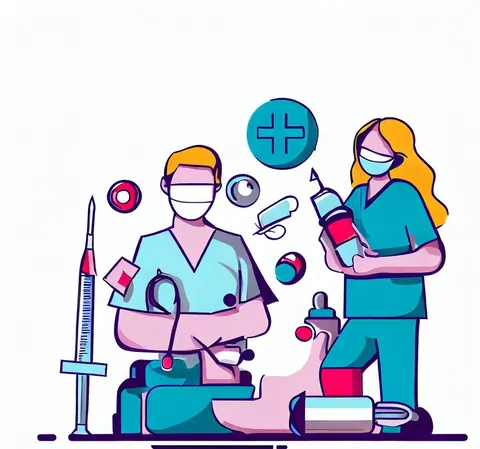Advanced Wound Care Techniques for Chronic Ulcers

Understanding Advanced Wound Care
Advanced wound care involves a set of specialized techniques and procedures designed to promote the healing of chronic ulcers and other complex wounds. Chronic ulcers, such as pressure ulcers, diabetic foot ulcers, and venous stasis ulcers, can be particularly challenging to manage due to their prolonged healing process and susceptibility to complications. Nursing students need to grasp the following key components of advanced wound care:

- Assessment: The first step in wound care is a thorough assessment of the wound. This includes evaluating the wound's size, depth, location, and the presence of any underlying issues like infection or poor circulation.
- Wound Cleansing: Proper wound cleansing is essential to remove debris, bacteria, and dead tissue. This can be done using sterile solutions and gentle techniques to avoid causing further damage to the wound.
- Debridement: In cases where there is dead or necrotic tissue, debridement is necessary to facilitate healing. This can be done through various methods, including surgical, mechanical, enzymatic, or autolytic debridement.
- Dressing Selection: Choosing the right wound dressing is crucial. Different wounds require different types of dressings, such as hydrocolloids, hydrogels, foams, or alginate dressings. Selection depends on the wound's characteristics and the stage of healing.
- Infection Control: Preventing and managing infections in chronic ulcers is vital. Nursing students must learn about antimicrobial dressings and the importance of maintaining a sterile environment during dressing changes.
- Moisture Management: Balancing wound moisture is essential for optimal healing. Nursing students should understand the principles of moisture balance and how to apply techniques like negative pressure wound therapy (NPWT) or advanced wound dressings to achieve it.
- Offloading and Pressure Redistribution: For ulcers like diabetic foot ulcers, offloading pressure from the affected area is crucial. Learning about orthopaedic devices like specialized footwear and casts is important.
- Patient Education: Nurses play a significant role in educating patients about wound care. This includes teaching them about signs of infection, the importance of adherence to treatment plans, and lifestyle modifications.
How to Excel in Assignments on Advanced Wound Care
Now that we've covered the basics of advanced wound care for chronic ulcers, let's discuss how nursing students can excel in assignments related to this topic:
- Comprehensive Research: Conducting thorough research is the foundation of any high-quality assignment. Here's a deeper look at this aspect:
- Utilize Academic Databases: Tap into reputable academic databases like PubMed, CINAHL, and Medline to access peer-reviewed articles, systematic reviews, and clinical studies related to wound care. These sources offer evidence-based information crucial for your assignments.
- Nursing Journals: Nursing-specific journals such as the "Journal of Wound, Ostomy, and Continence Nursing" and "Advances in Skin & Wound Care" are goldmines of knowledge. They often publish cutting-edge research and case reports.
- Reputable Websites: While academic sources are essential, trustworthy websites like those of professional nursing organizations (e.g., Wound, Ostomy and Continence Nurses Society) and government health agencies (e.g., CDC) can provide valuable supplementary information.
- Case Studies: Integrating real-life case studies when doing your nursing assignments can add depth and practicality to your work. Here's how to go about it:
- Patient Scenarios: Choose relevant patient scenarios that align with the specific type of chronic ulcer you're discussing. Provide detailed information about the patient's medical history, wound characteristics, and any complicating factors.
- Challenges Faced: Highlight the challenges the patient faces, such as slow wound healing, infection, or pain management issues.
- Application of Techniques: Describe how the advanced wound care techniques you've researched can be applied in these specific cases. Use evidence-based practices to guide your recommendations.
- Evidence-Based Practice: Emphasizing evidence-based practice is crucial in nursing assignments. Here's how to incorporate it effectively:
- Cite Relevant Studies: When making recommendations or discussing treatment options, cite relevant studies, systematic reviews, or clinical trials that support your arguments. This adds credibility to your work and demonstrates your understanding of the scientific basis for your suggestions.
- Evaluate the Quality of Evidence: Consider the quality of the evidence you're citing. High-quality randomized controlled trials hold more weight than anecdotal reports.
- Reflect on Best Practices: Reflecting on best practices involves critical thinking and the application of theoretical knowledge. Here's how to do it:
- Analyze Best Practices: Review the best practices in advanced wound care that you've learned about in your research. Understand why these practices are considered effective and how they align with the principles of wound healing.
- Application in Context: Apply these best practices to the specific chronic ulcer scenario you're discussing in your assignment. Explain why certain techniques or dressing choices are more suitable in that context based on evidence and guidelines.
- Include Visual Aids: Visual aids can enhance the clarity and impact of your assignments. Here's how to use them effectively:
- Images and Diagrams: Incorporate images or diagrams of different wound types, wound assessment tools, and wound dressings. These visuals can help your readers better understand complex concepts.
- Tables and Charts: Use tables and charts to present data, comparisons, or treatment algorithms. Visual representations can make information more accessible and memorable for your audience.
- Stay Updated: The field of wound care is dynamic, with new research findings and guidelines emerging regularly. Here's how to stay current:
- Subscribe to Journals: Subscribe to nursing journals and wound care publications to receive the latest research and updates.
- Attend Conferences: Consider attending wound care conferences and seminars to learn about the latest advancements and network with professionals in the field.
- Online Resources: Explore online resources, webinars, and forums dedicated to wound care to stay informed about recent developments.
Resources for Nursing Students
To further help with your nursing assignments on advanced wound care, here are some valuable resources:
- Nursing Journals: Access journals like the "Journal of Wound, Ostomy, and Continence Nursing" and "Wounds" for the latest research and articles on wound care.
- Professional Organizations: Join organizations like the Wound, Ostomy and Continence Nurses Society (WOCN) for access to educational resources and networking opportunities.
- Online Courses: Enroll in online courses on wound care offered by reputable institutions to deepen your knowledge.
- Books: Consider textbooks like "Wound Care Essentials" by Sharon Baranoski and Elizabeth A. Ayello for comprehensive reference materials.
Conclusion
Mastering advanced wound care techniques for chronic ulcers is not only essential for patient care but also a critical aspect of nursing education. As a nursing student, you now have a foundational understanding of advanced wound care principles and a roadmap for excelling in assignments related to this topic. Remember to conduct thorough research, utilize evidence-based practices, and stay updated with the latest advancements in the field. With dedication and the right resources, you can become a proficient wound care nurse and excel in your academic pursuits. For more assistance with nursing assignments, don't hesitate to hire someone to do your nursing assignment and offer expert guidance tailored to nursing students' needs. Good luck with your studies and assignments!